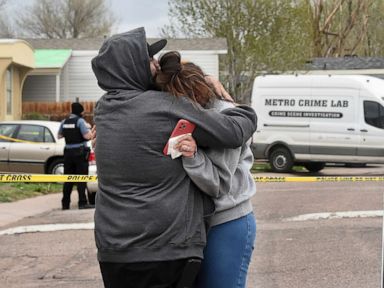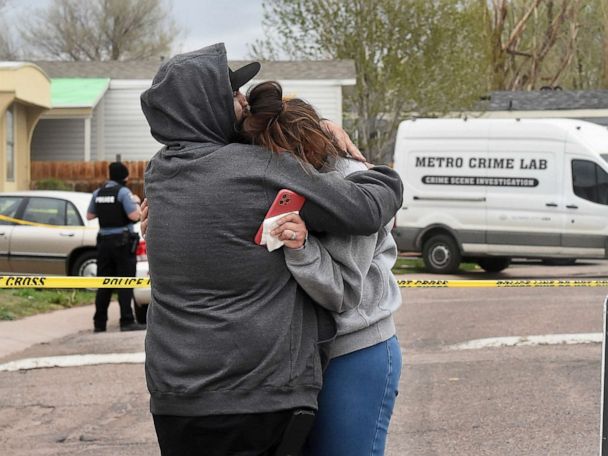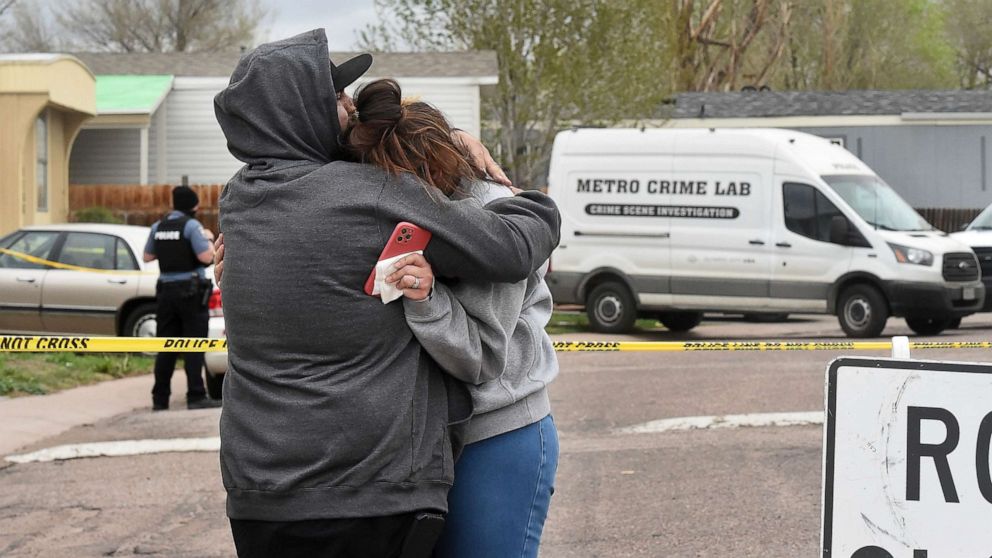





The murderous wrath of a scorned boyfriend in Colorado Springs, Colorado, recently had deadly consequences for his girlfriend and her family, police said.
The devastating May 9 attack, which unfolded on Mother’s Day while the man’s girlfriend and family were celebrating a birthday, served as a sobering reminder of the inextricable link between domestic violence and gun homicides — and the ripple effect it has upon the innocent lives nearby.
The gunman reportedly opened fire after he wasn’t invited to the party, killing six people ranging in age between 21 to 52, before taking his own life, police said.
Domestic violence played a role in 54% of mass shootings in the U.S. between 2009 and 2018, according to Everytown For Gun Safety, a nonprofit organization that advocates for gun control. In 61% of mass shootings, defined as having four or more victims, from 2014 to 2017, perpetrators had previously been involved in the justice system for domestic violence offenses, according to a 2019 study by the American Society of Criminology.
Often, domestic violence gun incidents end up claiming the lives of romantic partners — and also the lives of bystanders, family members and witnesses nearby.
Colorado Springs Mayor John Suthers said after the tragic shooting, “We have to remember that 20% of the victims of homicides related to domestic violence are not the partners,” citing a 2014 report analyzing intimate partner homicides published in the American Journal of Public Health.
“They are bystanders, police officers that show up, people at the wrong place, wrong time, and that is what happened here. We had a lot of innocent people that were killed,” he added.
Domestic violence attacks kill bystanders
Jenn Doe, the executive director of the Denver Domestic Violence Coordinating Council (DDVCC), which tracks the number of annual domestic violence deaths in Colorado, told ABC News a “handful” of bystanders are killed each year in the state from these kinds of incidents.
While there’s no national tracker of data on domestic violence fatalities and bystander deaths, several states put together their own reports.
In Colorado, there were 70 domestic violence-related fatalities in 2019, and 55.7% of the fatalities were the primary victims of domestic violence, while 5.6% were friends, family members, neighbors, children and other bystanders, according to Colorado’s latest Domestic Violence Fatality Review Report. Perpetrators of domestic violence accounted for the other fatalities.
In Georgia’s Fatality Domestic Violence Report, in cases from 2004 to 2018, 12% of fatal domestic violence victims were someone other than the perpetrator or intimate partner who was killed, meaning they were children of the intimate partner, new dating partners, family members or bystanders.
This is a deadly pattern that has been repeated time and time again.
Even in shootings that don’t target intimate partners, many perpetrators of mass shootings have a history of domestic violence and harassment.
The shooter behind the 2016 Pulse Nightclub shooting in Orlando, Florida, that claimed 49 lives physically abused his wife for years, she told investigators. The perpetrator behind the 2017 Sutherland Springs, Texas, church shooting that killed 26 was court-martialed in 2012 for assaulting his then-wife and child, police said. The 2007 Virginia Tech shooter was accused of stalking two female classmates before he massacred 32 people, authorities said.
Firearms increase risk of multiple fatalities in domestic violence incidents
Julia Weber, the implementation director at Giffords, a gun control advocacy and research organization, said it’s imperative to remove firearms from domestic abusers — the vast majority of whom are male — not just for the safety of their family members and partners but for the greater public as well.
“There’s over a million women alive today who have been shot or shot at by an intimate partner,” she told ABC News, citing Gifford’s data. “Temporarily taking firearms out of the equation can decrease the risk not only for that individual victim, but also for the extended family and co-workers.”
Weber pointed to the 2018 mass shooting at Mercy Hospital and Medical Center in Chicago, where a gunman shot his ex-fiance six times, and in the barrage of 40 bullets also killed an attending physician, a police officer and a pharmacy resident, police said.
The presence of guns dramatically increases the risk of multiple homicide victims in domestic violence incidents by 70.9%, according to a 2020 study published in the Journal of the American Academy of Psychiatry and the Law. That study also found 40% of male-perpetrated intimate partner homicides resulted in multiple fatalities.
Experts say this is a reason why domestic violence needs to be flagged in its early stages — such as verbal abuse or stalking — to end escalation that can claim multiple lives.
“It’s really important that for people who are convicted of stalking, or for whom a restraining order is issued for stalking, that they are prohibited [from having firearms], and that we actually get the firearms that they might currently own,” Weber said.
“This is something that puts the entire community at risk, not just the victim,” Doe, of DDVCC, added. “We need to be holding accountable perpetrators of domestic violence so that their behavior doesn’t escalate into that public sphere.”
States work to strengthen gun laws against domestic abusers
The Lautenberg Amendment, which became federal law in 1996, bans people convicted of domestic violence misdemeanors and those subject to domestic violence protective orders from purchasing or possessing guns, but advocates say courts do little to enforce the law.
In Colorado, local gun reform activists such as Lydia Waligorski are putting a new bill on the table that could have potentially prevented the Colorado Springs shooting by closing the “boyfriend” loophole in current Colorado laws, which are specific to married couples and couples who share children or a household.
If there had been a reported domestic violence case in the Colorado Springs shooting, and even if there had been a protection order, the suspect “would have been able to have that firearm, because they were just dating,” Waligorski said, noting that the proposed bill would close that loophole.
Currently, 26 states and Washington, D.C., have laws prohibiting abusive dating partners from having guns, and 23 states and D.C. require prohibited domestic abusers to relinquish their guns.
Those laws have led to fruitful numbers — a 13% reduction in intimate partner firearm homicide rates, according to Everytown. States that require abusers to relinquish guns have a 16% lower intimate partner firearm homicide rate, according to the group.
Advocates stress that this isn’t just a gun issue, that at its root, it’s a gender-based violence problem in America.
“Domestic violence is gender-based violence. It is primarily men acting out violently against women,” Doe said.
“That doesn’t represent all cases, but there’s an important connection between people who see women as property or as less valuable,” Doe said, “and people who just don’t seem to have appreciation for human life in general.”
If you or a loved one are experiencing domestic violence, please call the National Domestic Violence Hotline: 1-800-799-7233 or access help through their chat at thehotline.org.
